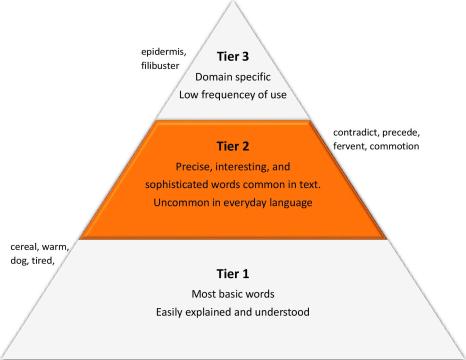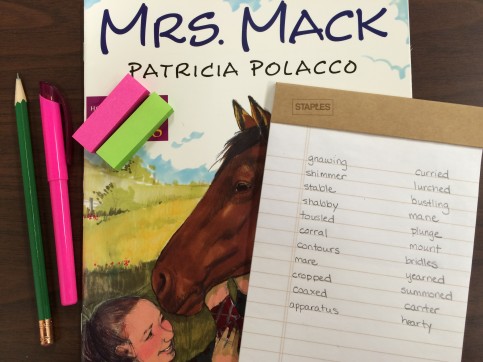During the first part of this series, I outlined specific places where authentic vocabulary words could come from. That list includes:
- Your current mentor texts
- Student’s independent reading novels
- Student’s writing
So, now, you’ve put systems into place and you’ve acquired a bunch of individual words to choose from for explicit vocabulary instruction. You are most likely thrilled to have so many words at your fingertips! However, when confronted with a long list of “good” vocabulary words, we know that it would be impossible to teach them all in an already packed school day. We know that of all the possible words, we must select a small number of words for explicit instruction, but that can be frustrating. Deciding which words to teach is challenging! Similar to the lack of information regarding what words to teach discussed during the last post, the Common Core State Standards also do not say anything about how to identify the specific academic and domain-specific words to teach.
There are various types of words to consider for instruction:
- words that are essential for comprehension of a specific text
- words that are important for developing a broader reading and writing vocabulary (but are not directly linked to a specific text)
- common words that students with a limited vocabulary are unlikely to know
- words that represent themes in narratives or key concepts in informational texts (but are not included in the selection)
- words with important structural features
Teachers are left wondering,
“Which words do I teach?”
Since we are working with words that have been authentically gathered from individual classroom sources, Beck and McKeown’s tier system would work best for selecting words for vocabulary instruction. This system sorts words into three tiers or levels, as pictured below.

Beck and McKeown recommend teaching Tier 2 words. Unfortunately, there is not a magical list of Tier 2 words (sigh), nor do Tier 2 words have grade-level designations. However, Linda Kucan’s article “What is Most Important to Know About Vocabulary?” (The Reading Teacher, Vol 65, Issue 6, 2012) gives guidelines for evaluating if words fall into the Tier 2 category.
Evaluation Criteria for Tier 2 Words
- Students do not ordinarily use the word or hear the word in daily speech, but it is often encountered in books.
- Students have knowledge or experience that would help them understand the word.
- The word frequently appears in texts across a variety of content areas.
- The word is useful or important for comprehending and writing about important ideas in a selection
- The word can be worked with in a variety of ways (students can build rich representations of the word as well as connect it to other known words)
Here is a list of possible vocabulary words I pulled from Mrs. Mack by Patricia Polacco (guided reading level P). Which word would you select for explicit instruction using the criteria outlined above?
I chose shabby, contours, coaxed, lurched, plunge, mount, yearned, and summoned. But remember, there is no “correct” answer. Selecting one word over another is up to each teacher and which words s/he thinks will get the most bang for their buck within the individual classroom. I chose these words because they will help students when they are reading and writing about ideas from the text and are words that are seen often in other texts. Many of these words can also be used in multiple contexts, so students will be able to construct high-level mental representations of each word. Some of the remaining words, especially those pertaining to horseback riding, are potential Tier 3 words.
I outlined how to do this selection process with a class mentor text. We can use this same approach with words that have been spotlighted from student writing and suggested by students from their independent novels.
Now you have a clearer view of how to select vocabulary words, but you may still be plagued by one small nagging question,
“How many words should I choose?”
The total number of words to teach students weekly will depend on the actual students sitting in your classroom. Your judgement and instructional goals will play a large part in the amount of words chosen. Think about your students’ existing vocabularies and general language skills, as well as the complexity of the average text experienced (by students during independent reading and through class readings).
A good target would be for students to learn about 500-600 words per school year. Very roughly, that would translate to 12-15 words a week. But fret not- this does not have to happen solely within your literacy block! We can assume that students are learning words in other content areas besides literacy. When learning about Landforms in Social Studies, students will learn word such as plain and plateau, or in a math lesson, students might learn the word product or quotient. So, it might be reasonable to say that in literacy, students should be explicitly taught 10 words a week.
I might pull 3 words from those suggested by students from their independent novels, 3 words spotlighted in student writing, and 4 from the current mentor text each week.
Once you’ve narrowed down your word selections, you are ready for the final step of the process- the actual instruction. Best practices in vocabulary instruction will be the last installment in this series. You’ll finally be able to put this behind-the-scenes work into action!
How many vocabulary words do you teach a week? What words would you have chosen from my list from Mrs. Mack by Patricia Polacco? Leave me a comment!
Let’s keep the conversation going-
Lindsay



This is helpful and practical. Thank you.
LikeLike
You’re welcome! I try to keep things as practical as possible. Classroom life can be very busy!
LikeLike